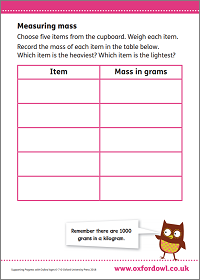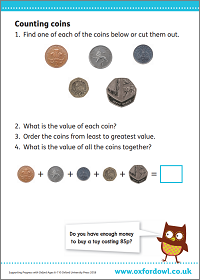Measurement in Year 2 (age 6–7)
In Year 2, your child will learn about the measurement of length, height, weight, volume, time, and money, and will be introduced to measuring temperature.
The key words for this section are measurement, capacity, and standard unit.
What your child will learn
Take a look at the National Curriculum expectations for measurement in Year 2 (age 6–7):
Measure using appropriate standard units
- length/height in any direction (cm/m)
- mass (g/kg)
- temperature (°C)
- capacity (ml/l).
Your child will know the difference between mass and weight:
- Mass is the measurement of how much matter an object is made from. It is measured in grams, kilograms, and so on.
- Weight is the measurement of the effect of gravity on an object. It is measured in newtons.
At this stage, your child will use the terms capacity and volume interchangeably when describing how much a container can hold.
Compare measures using <, >, and = symbols
Your child will compare measures using simple multiples like ‘half as high’ and ‘twice as wide’.
Use the £ and p symbols to record and calculate with money
Your chill will learn to recognise the value of all coins and notes. They will learn to use the symbols £ and p accurately, recording pounds and pence separately.
They will be able to add up coins and notes accurately. They might need to combine amounts of money to make a particular value. For example, they might be asked to find different ways to make a total of 20p:
- one 20p coin = 20p
- two 10p coins = 20p
- four 5p coins = 20p
- two 5p coins and ten 1p coins = 20p
- one 10p coin and two 5p coins = 20p
- and so on.
Solve simple problems using one unit of measurement
‘If I buy an apple for 15p, a bag of carrots for 45p, and a pint of milk for 60p, how much will my shopping come to all together?’
15p + 45p + 60p = 120p
They will solve simple subtraction problems by finding change in either pence or pounds. For example:
‘If my shopping comes to £12 and I pay with £15, how much change will I get?’
£15 – £12 = £3
Compare and sequence intervals of time
They will learn that there are different numbers of days in each month and that there are 12 months in a year. They should also be able to put the days of the week and the months of the year in order.
Tell the time to five minutes
Your child will be able to draw the hands on a clock face to show the time and to tell the time in words (for example, to say ‘half past three’ or ‘four fifty-five’).
Know the number of minutes in an hour and the number of hours in a day
Your child should know that there are 60 minutes in an hour and 24 hours in a day.
How to help at home
There are lots of everyday ways you can help your child to understand measurement. Here are just a few ideas.
1. Explore length and height
When you are out and about, point out measurements of length or height in the real world – like width restrictions when driving or height restrictions for fairground rides.
To help your child compare different lengths and heights, you could ask them to choose five objects from around your home and measure their length using a ruler. Ensure that your child uses their ruler correctly, beginning at the zero and measuring the lines accurately.
Then, ask your child to order the objects from longest to shortest. Can they write three sentences to describe the objects using the words longer, longest, shorter, and shortest?
2. Explore mass, capacity, and volume
To practise comparing and ordering mass, why not ask your child to compare food items from the kitchen? Ask your child to explain which item has the greater mass and why. Encourage them to use the less than (<) and greater than (>) symbols to compare. For example:
Compare a 500g bag of pasta and a 375g tin of tomatoes.
500g > 375g and 375g < 500g
You could ask your child to find a few more items and put them in order, from the item with the least mass to the largest mass. For example:
Order a 500g bag of pasta, a 375g tin of tomatoes, a 1000g box of detergent, and a 750g box of cereal.
375g < 500g < 750g < 1000g
Discuss whether items are measured in grams or kilograms. If possible, encourage your child to use different types of weighing scales, including balance scales and digital scales.
Your child could also compare objects with different capacities. Take a selection of empty containers and ask your child to guess which container holds the most. Then, they can test their guess by seeing how many cups filled with water it takes to fill each container. Encourage your child to discuss and record their findings. See if they can use terms like capacity or volume when you are talking.
Activity: Measuring mass

Record the mass of household items.
3. Bake together
You could try following a recipe with your child. Help them weigh the ingredients using digital or balance scales (whatever you have at home). Can they tell you the mass of the ingredients in kilograms and grams?
For baking inspiration, take a look at our free recipes.
4. Try money activities
To help your child get used to the value of coins and notes, let them use money when you are shopping. Be sure to point out prices in the supermarket and to talk about the coins and notes we use.
To get your child used to the value of coins, you could ask them to investigate all the different ways to make £1. Or, if they are collecting coins in a piggy bank, ask them to find the total amount of money they have inside. Help them by sorting coins into smaller groups and then adding those groups together to find the total.
You could also help your child to practise calculating with money by telling them that they have £2 to spend and asking them to work out what they could buy. This shows your child the real-world impact of their maths skills!
Activity: Counting coins

Cut out the coins and practise money skills.
5. Get to grips with time
Your child could use their knowledge of fractions to tell the time on an analogue clock to the hour, at half past, at quarter past, and at quarter to the hour. Encourage them to tell the time at different points during the day, including to the nearest 5 minutes.
It is important your child knows how to compare and record time in terms of seconds, minutes, and hours using vocabulary like o’clock, am/pm, morning, afternoon, noon, and midnight.
Try to talk to your child about how different units of time relate to each other. For example, they should know that there are 60 seconds in a minute and that there are 24 hours in a day. You could ask your child to work out problems such as finding out how many seconds there are in three minutes.
6. Make a clock together
Making a clock with your child will help them get to know the features of an analogue clock – for example, the long hand is the minute hand and the short hand is the hour hand. You could add words to the clock to support your child, such as quarter past, half past, and quarter to.
Your child may well be more keen to practise telling the time using a clock they have made themselves! Take a look at the activity sheet below to find out how to make a paper clock.
Activity: Make your own clock

Tell the time with your hand-made clock.
